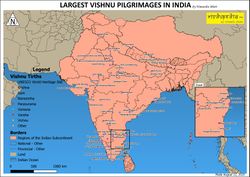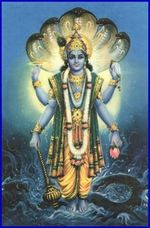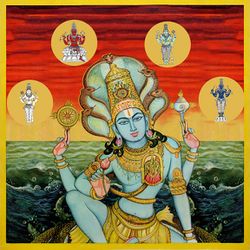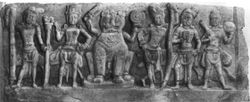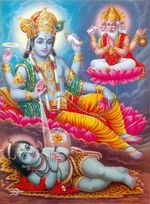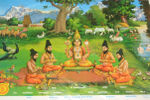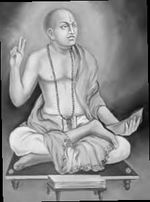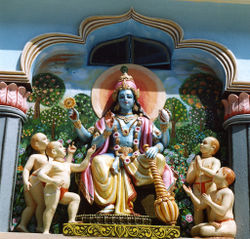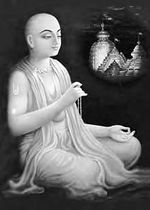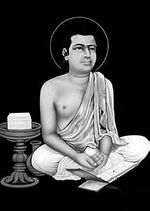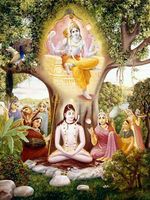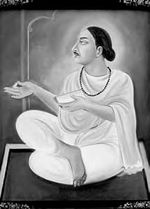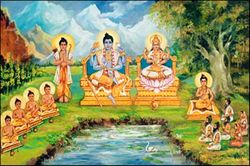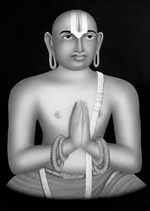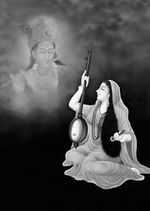By Swami Purnanda and Himanshu Bhatt
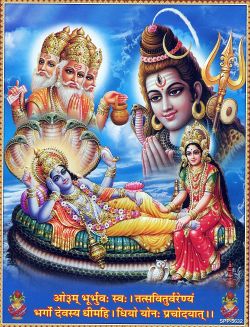
A Vaiśnava is a devotee of Brahm (God) who is called Narayan and takes the forms of the Earthly Vishnu Aditya and Krishna Vasudeva, as well as others avatars. The sect's name is after Vishnu, but it is also known as Bhāgvatam and Satvatam[1] after Krishna, and Narayaniya after Narayan the Supreme Lord. Because it is the worship of Narayan, whom it regards as the one true God, the sect is also known as Ekanta Dharm.[2] Although Vaiśnavam has persons recognized as avatars, it is not a requirement to believe that the persons were in fact avatars or Narayan because the sect is centered on Narayan. Many Vaiśnavas that worship Vishnu like to identify Narayan as appearing the same as Vishnu and call him Maha-Vishnu, while many Vaiśnavas that worship Krishna like to imagine him appearing the same as Krishna. So basically they imagine the Earthly incarnation of Vishnu or Krishna as just a physical reflection of Narayan in heaven. While some argue that Narayan, Vishnu, and Krishna have no relation and that this sect is a combination of random deities, the sect has an established history with the triad relevant. It is also important to understand that Vishnu was 1 of the persons on the Divine Council of 33, and that because the succeeding persons who held the position that Vishnu held were either in the lineage of Vishnu or of the same Aditya gotra he was. For example, the "Vishnu" that slew Jalandara was not the original Vishnu that the Vaiśnavam sect has its origins in and that was one the first Divine Council of 33.
The principle of avatars or vibhavas is stronger in Vaiśnavam than other sects, which is why the sect is normally practiced in the Pāñcharātra sense wherein Narayan may be worshipped alongside his incarnations. Sects adhering to this include the Hare Krishna, Pushtimarg, and Swaminarayan.
The name Narayan is first mentioned in the Rig Veda as a compiler of a verse, but Narayan as God first appears in the Satapatha-Brahmana[3], and the Narayan Sukhtam first appears in the Taittiriya Aranyaka[4] and in this scripture the name Hari is connected to Narayan. The most popular Vaiśnava mantra, "Hari Aum," occurs first in the Kasha and the Praśna Upanişads wherein they end by the exclamation.
While Narayan, Hari, Krishna, and Vishnu are the main epithets of God in Vaiśnavam, other lesser common ones (but still popular) include, Achyut, Badri, Janardan, Ram (not only referring to Ramchandra Ikshvaku), Rishikesh, Sriman, and Srivatsa. Krishna is the primary object of devotion in the Bhāgvata and Gaudīya traditions. He is worshiped in several forms: as Vasudeva Krishna (as the Supreme Being), as Gopāl Krishna (baby Krishna), as Vanamālī Krishna (the young cowherd), and as the king of Dwāraka.
| O mind, meditate on Mura’s adversary;
O hands, be clasped in the worship of Sridhara; O ears, hear the great deeds of Achyuta; O eyes, be fixed on Krishna; O feet, go to the temple of Hari; O nose, smell the tulsi at the feet of Mukunda; O head, bow down to Adhokshaja. |
||
—Kulashekhara Alvar, Mukundamala | ||
[edit]
Vaisnavism is mainly a tradition of bhakti. This bhakti has been defined and explained in different ways by different teachers. Unmotivated devotion (ahaitukī bhakti) to God is preached in the Bhagvata Purana: ‘Sa vai pumsām paro dharmo yato bhaktir-adhoksaje, ahaituky-apratihatā yayā’’tmā samprasīdati;That is the highest religion of humanity from which arises motiveless and uninterrupted devotion to God that fills the soul with bliss.’[5] The Narada Pāñcharātra defines bhakti as the realization that God alone is ‘mine’ (truly one’s own), accompanied by divine love (preman) and devoid of attachment to any worldly object. In later Vaiśnava tradition, a distinction is drawn between bhakti and preman. Bhakti is spontaneous attachment for God, being entirely possessed by and absorbed in him. Preman is the most concentrated form of this love, characterized by that intense attachment to God which purifies the heart completely. Preman is the culmination and fulflment of bhakti, its utmost perfection. This is also the basis of the two divisions: vaidhī or sādhana bhakti (ritual devotion) and rāgānugā or premā bhakti (the devotion consequent upon intense attachment).
A definition of a Vaishnav is given:
| Ekantin is one who gets alms by begging from those who are devoted to the six deeds (dāna, pratigraha etc.) and worships God. He hides the secrets through the eight-limbs conduct. He has pupils of good character and deliberates on Ultimate Reality. He has pupils of good character and deliberates on Ultimate Reality. He has all these by heredity. | ||
—Jayākhya Samhitā 22.11.13a [6] | ||
The Vishnu Purana 6 characterizes Satvats as worshippers of Vasudeva.
Worship Customs[edit]
The Marks of Vaidhī Bhakti[edit]
Vaidhī bhakti has nine aspects (navalaksanā or navadhā)--all directed to Vishnu: ‘Śravanam kīrtanam vishnoh smaranam pādasevanam, arcanam vandanam dāsyam sakhyam-ātmanivedanam.’[7]
- listening to the name and glories of the Lord
- chanting his holy name
- constant remembrance
- service
- worship
- salutation
- servitude
- friendship, and
- self-surrender
These nine ways of worshiping Vishnu are followed by all the Vaiśnava schools as vaidhī bhakti. Each school has its own approach, emphasizing one or more of these aspects. According to Nārada, dedication of all actions to the Lord and extreme yearning on forgetting him are marks of devotion. The lineage of Parāśara holds that attachment to worship and other rituals is the mark of bhakti. Garga maintains that speaking of His glories is the sign of devotion. Śāndilya holds that love for the Self is bhakti. Another aspect of devotion especially stressed in the Vaiśnava tradition is association with and service to devotees of the Lord. The Gaudīya Vaiśnavs hold that to have utmost taste for taking the Lord’s name, compassion towards all jivas (living beings), and service to devotees (initiated Vaiśnavs) are the means to as well as marks of devotion. But it is śaranāgati that is most important for a Vaiśnava spiritual aspirant. This śaranāgati has six aspects ‘Ānukūlyasya samkalpah prātikūlyasya varjanam, raksisyatīti viśvāsa goptrtvavaranam tathā; ātmaniksepakārpanye sadvidhā śaranāgatih.’ :
- resolve to subordinate one’s will to the divine will,
- avoidance of all that is contrary to His will,
- firm faith that the Lord is the saviour of all,
- acceptance of the protective grace of the Lord,
- total surrender to Him, and
- awareness of one’s poverty (of spirit)
Vaidhī bhakti is further categorized into three groups according to the three gunas: sāttvika, rājasika, and tāmasika.
Most Important Worship Methods[edit]
- See also: Hari Nama Keerthanam
No other Hindu tradition (or any tradition in general) encourages the chanting of God's names more than Vaiśnavam, which teachers that because we live in the Kali Yuga, the easiest yajna (sacrifice) is Sankirtan or Nam Jap ("Name Repetition.")
- Most Important Mantras
- Hari Aum
- Hari Nām
- Hari Sharanam
- Aum Namo Nārāyanāya (Ashtakshara Mantra or Sri Vaiśnava Mantra)
- Aum Namo Nārāyanāya Vidmahe, Vāsudevāya dhimahi, tan no Vishnu prachodāyat
- Aum Namo Bhagavate Vāsudevāya
- Aum Dev Devāya Namo Namā
- Klim Krishnāya Govindāya Gopijana-vallabhāya svāha (Gopal Mantra)
- Hare Krishnā, Hare Krishnā, Krishnā Krishnā, Hare Hare / Hare Rām, Hare Rām, Rām Rām, Hare Hare (Mahāmantra[8])
- Most Important Consecrated Pujas
Rāgānugā or Premā Bhakti[edit]
The highest form of devotion is that which transcends all the three gunas. It is love for love’s sake alone. It is a spontaneous and uninterrupted inclination of the mind towards the Lord without even the desire for liberation (mukti). It is supreme bhakti, or preman—intense, uninterrupted, unalloyed, and motiveless love towards God, which leads to God-realization.
This preman surpasses all other types of bhakti. Sri Ramakrishna says, ‘The mature stage of bhakti is bhāva. When one attains it, one remains speechless while thinking of Satchidānanda. The feeling of an ordinary man can go only that far. When bhāva ripens, it becomes mahābhāva. Prema is the last’[9]. When love towards God is intensified, a sweet relationship is established between God and the devotee. This rāgātmikā or rāgānugā bhakti manifests in five different attitudes (bhāvas): śānta (calm), dāsya (serviceful), sakhya (friendly), vātsalya (parental), and madhura (amorous). Several sentiments go to make each attitude, and each bhāva subsumes the sentiments inherent in the preceding attitude. For instance, in śānta bhāva the devotees enjoy divine bliss through meditation on the transcendental beauty of the Deity and adore him with all their hearts’ devotion. When this love matures into a personal or relational love, the devotees serve the Deity much like a servant serves the master. This stage of love includes sneha (affection), pranaya (friendship), māna (pique), and rāga (attachment). A servant enjoys both the wealth (aiśvarya) and sweet affection (mādhurya) of the Lord. Next the devotee approaches even nearer and loves the Deity as a friend (sakhā). This type of love includes anurāga (love as a constant freshness) in addition to the sentiments mentioned earlier. When love rises to a still higher level, it manifests as parental affection (vātsalya) for the beloved. All the qualities inherent in friendly love are further intensified and awareness of aiśvarya is dispelled; only mādhurya prevails. Up to this stage of parental love, the bhakti is relational (sambandhātmikā). When the last vestige of remoteness of the Deity vanishes from the mind of the devotee, two more mental states become manifest: bhāva (intoxication) and mahābhāva (supreme love-intoxication). The personality of the lover merges with the Beloved. The lover concentrates his or her whole being on the Beloved and becomes united with the Deity in spirit. This is the highest consummation of love for God. This has been described as amorous love (kāmātmikā), which is considered the highest form of contemplation in the Vaiśnava tradition. The devotees of this grade do not want liberation or anything other than divine communion—enjoying the absolute sweetness (mādhurya) of the Lord. This is the culmination of preman, the purest love for the beloved. The state where separation is overcome and total union between the devotee and the Beloved takes place is mahābhāva. The deep impact of this experience affects the entire being—the mind, body, and soul of the devotee. It manifests externally as the sāttvika vikāras (unaffected emotions), which are recognized to be eight in number: sveda (perspiration), stambha (stupor), romāñca (horripilation), svara-bhanga (broken voice), vaivarnya (pallor), aśru (tears), vepathu (tremor), and pralaya (loss of consciousness). These manifestations take place only when the mind becomes extremely pure and totally free from all worldliness. Sri Ramakrishna points out that that ‘the ordinary jīva does not experience mahābhāva or prema. He goes only as far as bhāva’ [10].
Scriptures[edit]
- See also: Vishnu's Relation to Krishna
Vaiśnavas typically reference the Vedic suktams as the first compiled scriptural basis for Vaiśnavam. Vaiśnava Āgama is an umbrella term for the entire Vaiśnava corpus. The Alvars of southern India had also referred to it as the Vaiśnava Veda. The complete spiritual wisdom any human should have is said to be the word of God or Ekāyana Veda which has been synonymously been called Mulaveda ("The Root Veda.") Ekāyana Veda has been a term used by both the Vaikhānas and Pāñcharātra sampradays. Ekāyana Veda was also briefly mentioned in the Chandogya Upanishad but without much description. Apart from the Bhagvad Gita, which is considered the literal 'word of God' or Brahmshabd, the Mukhya Upanishads (primarily the Vaiśnava ones) and Brahm Sutras are usually given precedence over other text, thus constituting the Prasthanatrayi ("Three Sources.")
[edit]
Five suktas[2] of the Vedas are believed by many Vaiśnavas to support Vaiśnavism in particular:
- The Purush Sukta (Rig Veda)
- The Narayan Sukta (Taittiriya Samhita)
- The Nila Sukta (Taittiriya Samhita)
- The Sri Sukta (Rig Veda)
- The Bhu Sukta (Taittiriya Brahmana)[3]
The Purush Sukta is considered a prequel (or “Purva-Narayan Sukta”), to the Taittiriya Samhita’s Narayan Sukta (also called “Uttar-Narayan Sukta.”) The latter sukta is also found in the Mahanarayan Upanishad.
Brahm as Narayan or Krishna do not occur in the Rig Veda but there are a few hymns dedicated solely to Vishnu[4][5][6], 2 dedicated to both Vishnu and Indra[7][8], and others wherein he is mentioned together with various deities.
[edit]
The Āgamas are the secondary scriptures, derived from the Veda. Although they have many divisions, the primary Āgamas are five in number: Saura, Śākta, Gānapatya, Vaiśnava, and Shaiv or Pāśupatya. The Vaiśnava Āgama shastra or corpus has two main subdivisions: the Vaikhānasa Āgama and the Pāñcharātra Āgama. As all these Āgamas are said to have been derived from the Veda, they are also called Śrauta Āgamas. God Almighty, according to Vaiśnavism is determined based on shad-gunyavigraham devam (6 qualities of godliness.)
The Vaiśnava tradition is primarily a tradition of bhakti, or devotion to God. Nārada defines bhakti as being of the nature of intense love for God: Sā tvasmin parama premarūpā.[11] The sage Śāndilya defines it as supreme attachment to God: sā parānuraktir-īśvare.[12] Two types of bhakti have been described by the teachers of bhakti: vaidhī and rāgānugā. Vaidhī bhakti involves worship and other rituals as instructed by the scriptures, whereas in rāgānugā bhakti, intense love for God is fundamental, and rituals and worship become secondary. The Vaikhānasa Āgama deals primarily with vaidhī bhakti, while Pāñcharātra Āgama teaches both vaidhī and rāgānugā bhakti.
Pāñcharātra Corpus[edit]
These agamas are based on the Ekayana recession of the Shukla Yajur Veda. The complete spiritual wisdom any human should have is said to be the word of God or Ekāyana Veda which has been synonymously been called Mulaveda ("The Root Veda"), Pāñcharātra, Sātvat, Tantra, and Āgama. Just before listing 108 shastras, Padma Samhita narrator Samvarta declares, "Narayan himself is the proclaimer of all the tantras." Ekayana Veda was revealed to a select few who were deserving of it; Sanat Kumars (Sanatan, Sujat, Sanak, Sananand) and Kapila. Later sages such as Atri , Angirasa , Pulastya , Pulaha , Kratu , Vasista and Svayambhuva learnt the Ekayana Veda from Narayan too.
| Having spoken thus, he (Narayan) taught the Veda called Ekayana, which is the main root of the great Veda-tree. | ||
—Parmeshvar Samhita 1.32c-33b | ||
It is said that from this Ekāyana Veda from which other scriptures, Vaiśnava and certain non-Vaiśnava ones, emerged. They are of 3 munibhashita shastra (scriptures compiled by human sages) classes - Sattvik (shastras composed by Narayan himself or ones whom he instructed), Rajas (shastras by persons influenced by Narayan but also ideas from other seers), and Tamas (shastras written by seers with no direct guidance from Narayan or persons that do.)
The oldest, and hence, most authoritative, scriptures that promote Pāñcharātra are the Satvata, Paushkara, and Jayakhya samhitas. Based on them are the Ishvara, Parmeshvara, and Padma samhitas. The Agastya, Kashyap, Naradiya, and Vishnurahasya samhitas are significant too.
| Classification | Text |
|---|---|
| Chief Scriptural Source | Ekāyana Veda (Bhagvad Gita is a part of it) |
| Satvik | Four Vedas, Ahirbudhnya Samhita, Aniruddha Samhita, Sanat Kumār Samahita, Narada Pāñcharātra, Hamsa Gita |
| Rajasik | Satvat Shastra, Mahabharata, Valmiki Ramayana |
| Tamasik |
Darshan shastras: Brahm Sutras, Sarvamūla Granthas
|
Theology[edit]
Pāñcharātra Āgama[edit]
- See also: Vishnu's Relation to Krishna, Dasavathara Stotram
The Pāñcharātra Āgama prescribes a theology wherein Narayan is fivefold, Para, Vyuha, Vibhabha, Antaryāmin and Arcā. The Pāñcharātra tradition follows both vaidhī and rāgānugā bhakti. The term Pāñcharātra can be traced to the Pāñcharātra Sattra (a yajna spread over five nights) described in the Shatapatha Brahmana.[13]. The term is first used in the Taittiriya Samhita[14] wherein a man named Babara Pravahini used the Pāñcharātra sacrifice to gain rhetorical power. The theology also states that Narayan has 3 main functions; 1) creation (srsti), sustinence (sthiti), and destruction (pralaya) of the universe, 2) Punishing evil-doers (nigraha), and 3) showering His blessings on those (anugraha.)
Reasons for the title Pāñcharātra:
- Ahirbudhnya Samhita: Narayan himself composed the Pāñcharātra Tantra and therein explained the secret of his five forms: Para (the transcendent), Vyuha (heavenly avataras), Vibhabha (Earthly avataras), Antaryāmin (the in-dweller within individuals) and Arcā (as consecrated images.)
- Brahma Sutra Bhashya[15] and Vedanta Deshika: Bhagavatas adhere to panchakala or 5 daily observances; abhigamana or prayers, upadana or collecting materials for worship (i.e., incense sticks, lotus flowers), ijya or sacrifice (i.e., worship, fasting), swadhyaya or self-study, and yoga or meditation.
- Isvara Samhita[16]: Vishnu taught this doctrine in five nights and five days to 5 rishis who were incarnations of his 5 weapons; 1) Śāṇḍilya (chakra), 2) Aupagayana (samkha), 3) Maunjyayana (gada), 4) Kaushika, 5) Bharadwaj.[17]
- Narada Pāñcharātra: The doctrine believes in 5 ratras or elements of Narayan; 1) Param Tattva, 2) Mukti, 3) Yukti, 4) Yoga, and 5) Vishay.
- Narada Pāñcharātra: Five classes of knowledge described in this book; 1) Knowledge of the Absolute Truth, 2) knowledge of Moksh, 3) Knowledge of devotional service, 4) Knowledge of mystic yoga, and 5) knowledge in the mode of ignorance.
- Narada Samhita: The karmendriyas and jnananendriyas are each 5 in number.
- Paushkara Samhita: Any benefits you receive through the Vedas, Vedanta, Puranas, Sankhya and Yoga shastra, you get easily through the Pāñcharātra. And ratra also means jnana (which is of five types, so is called artha panchakam.)
- Vihagendra Samhita: Vishnu taught this doctrine in five nights and five days to Ananta, Garuda, Vishwaksena, Brahmā, and Rudra.[18]
- Vishwamitra Samhita: The karmendriyas and jnananendriyas, keep the soul attached to the world but Pāñcharātra helps conquer them to achieve Moksh.
- Markandeya Samhita: Because the Pāñcharātra Agama was narrated by Narayan to Brahmā over a period of five nights.
Pāñcharātra gives credit to the Kumār Sampraday in that it declares [according to the Parama Samhita] and that Sanak was taught it by Vishnu himself.[19] Historically, Śāṇḍilya Kashyap was, after Samkarshana, the greatest promultagor of Pāñcharātra in the Kali Yuga. According to the Ishvar Samhita, after having learned it from Samkarshana, he taught it to Sumantu, Jaimini, Bhrgu, Aupagayana, and Maunjayana. In the
Ekantika Dharm refers to Vasudeva as well, but according to the Narada Pāñcharātra, there were 2 kinds of Ekantins - pure (Vasudevaikayajina or "worshiping only Vasudeva") and mixed (who worshiped other forms of Vasudeva.) The "Mokshadharmaparvan" section of the Mahabharata states that the worship of Vasudeva evolved from ekavyuha (only Krishna), to dvivyuha (him and Samkarshan), then trivyuha (the prior 2 and Pradyumna), and chaturvyuha (the 3 plus Aniruddha.) Later, Sambha too was added to the regular pantheon.
The Pāñcharātra tradition of Vaisnavism and the Nārāyanīya section in the Śāntiparvan of the Mahabharata have great similarity. The primary aim of the Pāñcharātra tradition is prapatti or śaranāgati (self-surrender), and the path is therefore called Ekāntika (with but one aim). According to Pāñcharātrikas, śaranāgati or total resignation is the main method of contemplation.
Important Venerated Persons[edit]
The Satvata and Ahirbudhnya[20] samhitas list 39 avatars of Vishnu/Krishna in chronological order (in [] are their probable first names and/or gotra names):
- Padmanabha [Aditya]
- Dhruva [Ikshvaku]
- Ananta [Naga]
- Shaktyatman (or Shaktisha) [Chakra]
- Madhusudana [Hayagriva]
- Vidyadhideva [Brahmā]
- Kapila [Brahmā]
- Vishwarupa [Trisuras Twashta Bhargava]
- Vihangama [Hamsa Brahmā]
- Krodatman [Yajna Varaha]
- Badavavaktra [Hayagriva]
- Dharma [Brahmā]
- Vagishvara [Hayagriva]
- Ekarnavashayin [Aditya]
- Kamatheshvar [[[Kurma]]]
- [Emusha] Varaha
- Nara Simha
- Piyushaharan (or Amritharan) [Garuda]
- Sripati [Aditya]
- Kantatman [[[Kama]]]
- Rahujit [Aditya]
- Kalanemighna [Aditya]
- Parijatahara [[[Kubera]]]
- Loknath [Manu Vaivaswata Ikshvaku]
- Shantatman [Narad]
- Datt Atreya
- Nyagrodhashayin [Aditya][21]
- Ekashringatanu [Matsya]
- Vamanadeha [Aditya]
- Trivikram [Aditya]
- Nara [Brahmā]
- Narayan (the rishi and brother of Nara) [Brahmā]
- Hari (the rishi and brother of Nara) [Brahmā]
- Krishna (the rishi and brother of Nara) [Brahmā]
- Parshurama [Bhargava]
- Rama Dhanurdhar [Raghava Ikshvaku]
- Vedavid [Krishna Dvaipayana Vyasa][22]
- Kalkin [Sharma]
- Patalashayana [Aditya][23]
Krishna Vasudeva himself isn’t mentioned on the list above because it’s acknowledged that he’s the earthly avatar of the heavenly Krishna. From enumeration mentions several persons of the Aditya gotra who may be either in the direct lineage of Vishnu Aditya or just of the same gotra in general. In either case, it is likely that these Adityas across different generations were held the position that Vishnu did on the Divine Council of the 33. In the list it can be difficult to decipher the identities of persons, but the mentioned Dharma is not the same as the father of Nara, Narayan, Hari, and Krishna because he's mentioned many generations earlier than them, and although 'Kroda' means turtle, Krodatman was actually of the Vahara (Boar) gotra. Vagishvara is a title that Shiva has, but the list refers to the person of the Hayagriva gotra who has the same name. Shaktyatman is the trickiest to identify but it is the attendant of Vishnu known as Sudarshana or Chakra, who is depicted being a weapon carried Vishnu's hand, and the reason for this is that the avatar is described as "iccha-rupa-dhara" meaning "will form flowing." That Sudarshana is an actual human can be seen in scriptures like the and Bhagavata and Vishnudharmottara[24] Puranas, and Sri Kalahasti Easwara Mahima[25]. A connection between 'iccha' (will) and Sudarshana is made in some scriptures like the Ahirbudhnya.[26] Further, although the name Vishwarupa was applied to Soma[27], Prajapati[28], Rudra[29] and the Supreme Brahm[30] the avatar in question is definitely the Daitya who was a son of Twashta Bhargava and was a great devotee of Narayana.
Sectarian Development[edit]
| Those who know the gradation of the devatas, and who understand the supremacy of Vishnu, are known as Ekantinā and masters of the knowledge of the divine hierarchy. Let those be alone called - Ekantins who know God to be one and the highest. | ||
—Madhavacharya | ||
The theological traditions of the other Vaiśnava sects have resemblance to the one developed by Rāmānuja, albeit with noteworthy variations. Teachers like Madhva, Vallabha, Nimbārka, and others also incorporated Rāmānuja’s ideas in their philosophies.
Brahmā Sampraday[edit]
This sampraday traces its foundation by Brahmā (someone of that gotra.)
The darshan it prescribes to is Achintya Bheda Abheda (basically an integration of Dwaita and Vishishtadvaita) and Dwaita itself.
The Bhagvata Purana confirms that instructions were imparted to someone of the Brahmā gotra, which then passed through the latter.
| Text 17: The infallible Supreme Personality of Godhead, Vishṇu, has descended into this world by His various partial incarnations such as Lord Hamsa [the swan], Dattātreya, the four Kumārs and our own father, the mighty Ṛṣabhadeva. | ||
According to the Bhagvata Purana, Hamsa was a Prajapati, confirming he was of the Brahmā gotra. The scripture continues to say that Hamsa imparted spiritual knowledge to Sanak the Sanat Kumār. Vihangama Hamsa's spiritual instructions are preserved in the Hamsa Gita. This Hamsa may be the same Brahmā as Vikhānas.
Vaikhānasa Āgama[edit]
The Vaikhānasa school of Vaisnavism claims its origin from the sage Vikhānas or Brahmā, meaning it was someone of the Brahmā or Prajapati gotra. Vaikhānasas claim to be a surviving school of Vedic agnihotra (fire ceremonialism) called the Taittiriya school of the Krishna Yajur Veda. Vaikhānasa tradition says that Vaikhānas rishi composed the Vaikhānasa Kalpasutra and taught four disciples[31], Atri, Bhrigu, Kashyapa, and Marichi, the procedures of samurtarchana (devotional service to Vishnu in images.) Most Vaikhānasa literature is mainly involved with ritual, prescribing the ceremonies and their rules of performance. The Vaikhānasas are primarily a community of temple priests, and their mode of worship is essentially oriented towards Vishnu. The Vaikhānasa Grhya Sūtras prescribe for the householders a daily worship involving the fabrication of an image of Vishnu. All gods and goddesses are supposed to be worshiped in Vishnu.[32] To the Vaikhānasas, Vishnu is the Supreme Being, the highest principle. He has two aspects: sakala (with form) and niskala (without form). The niskala aspect is his essence as all-pervasive Being, while his conditioned presence (the sakala aspect) gracefully responds to devotional intent and meditation. Vaikhānasa ritual theory is based on the fivefold conception of Vishnu; as Brahm, Purush, Satya, Achyuta (the immutable), and Aniruddha (the irreducible aspect.)[33] Worship entails venerating Vishnu, and many times his 4 attendants; Achuta, Satya, Purusha, Aniruddha. This school's name was also Ekartika.[34]
Moksha is release into Vishnu’s abode, called Vaikuntha. It can be attained by the practice of japa (devoted repetition of a mantra or prayer), hūta (sacrifice), archanā (service to the image), and dhyana (meditation conforming to a yogic regimen). Four types of moksha have been described: sālokya (to live in the abode of God), sāmīpya (to live near God), sārūpya (to have a form akin to that of God), and sāyujya (being united with or merged in God). The last one is considered the ultimate moksha. The Vaikhānasa treatises speak of four abodes of Vishnu: Āmoda, Pramoda, Sammoda, and Vaikuntha, where Vishnu, Mahā Vishnu, Sadā Vishnu, and Nārāyan respectively preside. Among the four sadhanas, archanā has been declared the highest by Marichi Samhita. By means of archanā',' one can enter Vaikuntha, the abode of Narayan, and enjoy eternal bliss.
Vaikhānasa ascetics tended to live in the forest, and their diet consisted mainly of wild rice and grains.[35]
Its Modern Madhva Tradition[edit]
Madhvācharya did not accept the Advaitic concept of jīvanmukti or nirvāna mukti. According to him, mukti is the attainment of Vaikuntha, the abode of Vishnu (sālokya), and attainment of a form similar to the Deity (sārūpya). Mukti or salvation is attained only by the grace of Vishnu, and even after mukti, the jiva remains the servant of the Lord. Ishvara and jiva are distinct entities. Bhakti, the only means of salvation, leads to the direct perception of the Deity. By performing proper worship, a person becomes competent for bhakti. This worship includes :ankana (marking the body with holy symbols), nāmakarana (naming children and other objects of love with holy names),and bhajana (service). Bhajana again is of three types: kāyika (physical), vācika (verbal), and mānasika (mental). Kāyika bhajana includes dāna (charity), paritrāna (acts of deliverance), and pariraksana (acts of protection). Vācika bhajana includes satyakathana (speaking the truth), hitavākya kathana (beneficial counsel), priyavākya kathana (sweet and gentle speech), and svādhyāya (study of scriptures). Mānasika bhajana comprises dayā (compassion), sprhā (desire for service to God), and śraddhā (faith in the guru and scriptures). Through these devotional practices, mediate knowledge is gained; this helps the growth of bhakti, which in turn results in enlightenment. This leads to a very ripe devotion which, in turn, leads to liberation—eternal servitude to God.
Kumār Sampraday[edit]
This tradition traces its foundation to a Sanat Kumār (1 of 4 sons of Brahmā), Sanak, who preached it. It is recorded that Sanak was trained in spiritual knowledge by Vihangama Hamsa (usually identified as an avatara of Vishnu, he was the son of Kashyap and Daksha’s daughter Vak[36].) As a result, this path is also referred to as Sanakandi Sampraday.
Its 2 major sects are the original Kumār Sampraday (whose tradition is traced thousands of years ago) and Nimbarka Sampradaya (whose tradition was founded by Nimbarka Acharya of the 7th century.)
The darshan it prescribes to is Bhedabheda (or Dvaitadvaita.)
Its Modern Nimbak Tradition[edit]
Nimbakacharya picked up this sect and built on it some of his own doctrines, including of Radha being a form of Narayan that should be worshiped alongside Krishna. The tradition of worship Radha was popularized by the Gaudīya tradition's Prabhu Chaitanya in The Bengal during the 15th century, and its tradition produced the Hare Krishna sect, which today is the largest Vaiśnava sect.
Gaudīya and Bhāgvata Tradition[edit]
The Gaudīya tradition of bhakti is based on the theology of the Bhagvatam and the Narada Pāñcharātra. The Gaudīya Vaiśnavas are worshippers of Rādhā and Krishna. The person Rādhā does not find mention in the Bhagvatam. This concept is derived from the Narada Pāñcharātra, where Pārvati, the divine consort of Shiva, says: ‘Tadrāse dhāranādrādhā vidvadbhih parikīrtitā; I held you in rāsa (divine play), that is why I am known as Rādhā by those in the know.’[37] Gopīs, the milkmaids of Vraja, are the embodiments of amorous love. The aggregate of this love of the gopīs is Rādhā, the embodiment of mahābhāva, the manifestation of hlādinī (the power of divine beatitude), which is one of the components of God’s svarūpa śakti (intrinsic powers).
This concept of Rādhā is a dominant theme in Vrindavan. The highest aspect of mahābhāva, known as mādana or maddening delight, is possessed only by Rādhā and no one else, not even by Krishna.[38] The delight Rādhā derives thereby is so immensely superior to what Krishna enjoys as the object of her love and is so irresistibly tempting that Krishna cannot suppress his eagerness to taste his own charms and sweetness as Rādhā does. Accordingly, there is an aspect of Krishna in which all the attributes of the Krishna of Vrindavan as well as those of Rādhā coexist.[39] In this aspect, Krishna, as the subject of mādana, relishes his own charms and sweetness. Chaitanya Mahāprabhu (or Śri Gaurānga), is considered to be this dual form—Krishna and Rādhā embodied in one frame—by the Gaudīya Vaiśnavs. So it is their custom to worship Gaurānga and his companions before worshipping Krishna.
The highest privilege for a jiva is to serve the Lord with madhura rati (amorous attachment) and be united with him, while maintaining one’s individuality, or while maintaining an idea of separation of Purusa and Prakrti (in Vaiśnava theological terms). To attain this state one needs to practise thinking of oneself as a young gopī, beautifully dressed, attending on Rādhā in her love-pastimes with Krishna, being the principal subordinate to Rūpamañjarī, the chief among Rādhā’s attendants (known as mañjarīs). Similar is the mode of meditation for devotees with other ratis [40].
| I will build a funeral pyre of sandalwood and aloe; light it by Your own hand. When I am burned away to cinders, smear this ash upon Your limbs. …let flame be lost in flame. | ||
—Mirabai | ||
But this is not possible for novices. So they are to prepare themselves by following the disciplines of vaidhī bhakti and navadhā bhakti. Thereafter the aspirant is expected to develop the sentiments inherent in the śānta, dāsya, sakhya, and vātsalya attitudes (sneha, pranaya, and the like). When the aspirant feels a deep attraction for and cannot bear separation from Krishna, he or she is established in bhāva. When this too ripens, the aspirant is established in the attitude of a gopī (gopī bhāva siddha), which, in select aspirants, culminates in mahābhāva. In this state, separation is removed and total union prevails; the aspirant enters into the supreme state of divine ecstasy and becomes one with the beloved enjoying the absolute mādhurya of Krishna. In this state, Krishna is looked upon as the nearest and dearest, nay—the person of the devotee is totally merged into that of Krishna, who is Narayan of Goloka, the advaya jñāna-tattva vastu the unique or non-dual essence of knowledge.
Important exponents of the Gaudīya tradition include Rūpa, Sanātana, and Jīva Gosvāmi. Among more recent traditions, ISKCON, the Hare Krishna school, follows the Gaudīya tradition.The ISKCON followers emphasize keeping count on the rosary ( japa mālā) while repeating the holy name, and consider the Bhagvatam, the Gita, and the Chaitanya Charitamrita their main scriptures.
Ekasarana Tradition[edit]
Śankaradeva considers the Bhagvatam as the embodiment of Krishna, and worships it as such. His followers usually do not worship images, but otherwise follow Gaudīya theology. They follow the teachings of the Bhagvatam, which prescribes the Kali Yuga method of worshipping the Supreme Being through kīrtana, identifying him with Krishna and Rama and addressing him as Mahāpurusa.[41] Thus the Purusottama of the Gita is the Mahāpurusa of the Bhagvata, and the theology of Śankaradeva is known as Mahāpurusiyā Dharma. Kīrtana, the main method of worship, is also called nāma-dharma. Just as the Gita enjoins giving up all duties and the practice of implicit resignation to the Lord,[42] Śankaradeva also lays great stress on eka śarana (surrender to the one Lord), which gives the school its other epithet eka śaraniyā. The concept of mukti is not given much importance by this sect, and it does not accept madhura bhāva or the Rādhā and gopī concepts of Chaitanya and the Bhāgvata school.
Rudra Sampraday[edit]
This tradition was preached first by someone of the Rudra gotra called Vishnuswami. 'Shiva', besides being the name of an ancient rishi of this gotra, has also tended to be used as anyone who came after from this gotra after Shiva's lifetime.
This sampraday has 2 sects; Vishnuswami (whose tradition is traced thousands of years ago) and Pushtimarg (whose tradition was founded by Vallabha Acharya of the 15th century.)
The darshan it prescribes to is Shuddhadvaita (pure monism.)
Its Modern Vāllabha Tradition[edit]
Although the school founded by Vallabha Acharya accepts the Vedas, the Bhagvad Gita, and the Narada Pāñcharātra as scripture, its primary authority is the Bhagvata Purana, because this text is directly related to Krishna. For Vallabha, Sri Krishna is the Sat-cid-ananda Parabrahman, also called Purusottama, even when present in his pastoral aspect as the cowherd boy of Vraja. Vallabha, however, does not accept the reality of Rādhā as in the Vrindavan Vaiśnava tradition and the Gaudīya tradition. According to Vallabha, the highest type of jiva is pusti jīva, the spiritually nourished jiva. This concept of pusti is derived from the Bhagvatam: ‘posanam tadanugrahah; posana is his grace.’[43] This is why Vallabha’s system of philosophy is called Pusti Mārga. One may practice bhakti rigorously, but divine grace is nonetheless the last word and the summum bonum of life. A pusti jīva prefers to serve the Lord, even eschewing Mukti. Bhajanānanda (the joy of devotional adoration) is infinitely superior to brahmānanda (the bliss of Brahman), and this can be had through service to Krishna, the Pūrna Purusottama (the Supreme Being totally manifest). To attain this privilege, the disciplines of nine-fold bhakti mentioned earlier have been prescribed. When this bhakti matures, the devotee enters into a transcendental state in this very life and gets a spiritual body in the life beyond, in order to be perpetually engaged in the divine service of the Lord.
Sri Sampraday[edit]
It is uncertain how old this sampraday is (with adherents claiming it traces back to Vishnu and Laxmi themselves) but this tradition was made more popular by Tamil Saint Nathmuni. It was then popularized by Ramanuja, who connected Vaiśnavism with other Vedic persons, including Indra and Varuna. Later in the 14th century, Bhakti Era patriarch Ramananda Swami preached Sri Sampraday in northern India after settling there. Its main doctrine is that Vishnu is God Almighty, and that Sri Lakshmi is His form that intercedes on behalf of worshipers by accepting their prayers to Vishnu (and to her as well.) It is interesting to note that the Yogamaya or spiritual energy of Vishnu in the universe (within scriptures of other Vaiśnava sects) has often been considered feminine. Today the sect also worships Vishnu's avatars too (Rama, Krishna, as well as Hanuman.)
The darshan it prescribes to is Vishishtadvaita.
Its Modern Rāmānuja Tradition[edit]
While Nāthamuni is traditionally considered the founder of the Śri Sampradāy and Yāmuna Acharya was the first āchārya of this sampradāy, it was Rāmānuja who established this school on a firm footing.
Bhakti: According to the Śrīvaiśnava tradition, bhakti is realizing one’s ultimate relationship with the Lord as his eternal servant. This relationship generates love for and attachment to him. Rāmānuja also equates bhakti with dhyana and upāsanā. Dhyana is the concentration of the mind on the Deity, and upāsanā, continuous thought of Him or Her. Bhakti has two stages: sādhana-bhakti (bhakti as means, i.e. ritual devotion) and phala-bhakti or sādhya-bhakti (bhakti as fruit). Sādhana-bhakti aims to inculcate strong faith in the Deity as the highest value and a sense of the utter transitoriness of worldly achievements. Sādhya-bhakti is being established in love for God, as a servant loves the master. This is the means to mukti. To achieve sādhya-bhakti, one must go through a seven-fold culture (sādhana saptaka):
- viveka, discrimination regarding what ought to be accepted and what to be given up, especially in relation to food;
- vimoka, control of passions like anger, jealously, and lust;
- abhyāsa, practice of disciplines like worship, japa, chanting the names of God, and pilgrimage, in order to maintain a constant memory of God as the indwelling principle (śesin) within oneself as well as in the whole universe;
- kriya, the five-fold works or sacrifices—to gods and goddesses through agnihotra (fire sacrifice) and other rituals, to the rishis through scriptural study, to one’s ancestors, to human beings, and to other living beings (bhūtas) through appropriate offerings;
- kalyāna, virtuous conduct, consisting in practicing virtues like satya (truth), ārjava (straightforwardness), dayā (compassion), dāna (charity), and ahimsā (non-injury);
- anavasāda, freedom from despair, dejection, pessimism, and the like, and maintenance of a cheerful and positive attitude of mind; and
- anuddharsa, absence of exultation or excitement, maintaining an even temperament in all situations.
Prapatti: By long and continued practice of these disciplines, one is established on the plane of vaidhī bhakti consisting of dhyana and upāsanā. Thereafter the aspirant ascends to the plane of paramā bhakti (supreme devotion), maintaining in oneself the knowledge that one is merely a śesa (a minute part of the whole, which is the Deity) and that the Deity is the śesin (the whole). Paramā bhakti is identical with prapatti (resignation). This state of being an eternal servant of the Lord is itself the highest goal. The idea of identifcation with the Supreme Being is not acceptable to the Śrīvaiśnava. According to this tradition, the Supreme Being or Purusottama is by nature devoid of all blemish and is full of limitless, unsurpassable, and countless auspicious qualities: ‘nirasta-nikhiladoso-’nava-dhikātiśayāsankhyeya-kalyānagunaganah’.[44]
[edit]
[edit]
Many other Vaiśnava devotees called sants preached the doctrine of love throughout India. Several sects have preserved the traditions they founded. These include the sects of Nimbārka, Rāmānanda, and Samartha Rāmdās, the Vārkarīpantha (worshippers of Vitthala or Vithobā of Pandharpur, including Nāmadeva, Eknāth, Tukārām, and Janābai among others); and smaller sects associated with Haridās and Dādu. Jñāneśvara blended bhakti with Advaita Vedanta in Jnaneshvari, his commentary on the Bhagvad Gita. The other sants have stressed bhakti as the path to God realization and advocated singing the name of the Lord and chanting his praise. These sants accepted and preached the path of pure devotion (premā bhakti), considering God a loving parent or master rather than as the divine lover of the Bhāgvata or Gaudīya tradition. An exception was Mīrābāi; she practiced and preached rāgānugā bhakti (passionate love) towards the Lord, viewing him as lover. Kabir was the most unique worshipper in the Vaiśnava tradition because he addressed God Almighty as Hari mainly, then Narayan, then Govind, and then Vishnu, but he heavily criticized worshiping God as someone of whom we have stories (i.e., Vishnu being a brother or having any connection to any deities) and incarnations. Regardless, he promoted his Hari-worship as Vaiśnavam, and his Kabirpanth is popular.
| Good is the bitch of a Vaiśnav: bad is a Shākta's mother;
For, the one hears Hari Nam, the other but deals in evil. |
||
—Poem 52, Section 40 (“Sloks of the Bhagat Kabir”), Sri Guru Granth Sahib | ||
| Orthodox priest expostulated: “This is not your religion. You have made yourself a Vaiśnava and call on Vishnu, Narayan, Gobind, and Mukand. This is our religion.”
Kabir replied: “On my tongue Vishnu, in my eyes Narayan, and in my heart Gobind dwells. When at the door of Yama they question me, what will you say, oh mad Mukand.” |
||
—Kabir Kassauti introduction | ||
Kabir received spiritual knowledge in Vaiśnavam from his preceptor Ramanand, who himself worshipped only Hari. He himself is believed in one Ramanandi tradition to have been the 4th spiritual successor to Ramanuja Acharya. His sampraday is popular.
[edit]
According to Sri Ramakrishna, in the present-day age of Kaliyuga, devotion as prescribed by Nārada is the way to God-realization. This involves intense love for God and total indifference towards everything contrary to God; and this is developed by singing the names and glories of God. Ramakrishna says that two things are essential to realize God: simplicity and yearning. It is necessary to establish a close relationship with God and impress deeply on the mind the idea that God is one’s very own. Knowing this, one must take refuge in God and develop an intense attachment for Him. He says, ‘God reveals Himself to a devotee who feels drawn to Him by the combined force of these three attractions: the attractions of worldly possessions for the worldly man, the child’s attraction for its mother, and the husband’s attraction for the chaste wife.’’[45] He prescribes four aids to contemplation:
- association with holy persons,
- solitude,
- discrimination (between the real and the unreal, to develop the conviction that God alone is real and all else unreal), and
- prayer for genuine faith and love for God.
He declares that God realization is the sole aim of human life, and that a still higher aim is to love God with all one’s heart and soul but without any ulterior motive. Mukti is a secondary matter for Ramakrishna, and is inferior to bhakti. The culmination of all knowledge is the realization that the same (and one) God has become the jivas, the universe, and all its components; it is to experience God in every thing and in every being.
[edit]
Although there are exceptions, formal renunciation is not an important component of the Vaiśnava tradition. However, some of the most reputed Sanatan ascetics were Vaiśnavas, such as ones from the Vaikhanasas and Ramanandi (were further classed into tyagis, nagas, and rasiks) sects. The renunciation practiced by its adherents manifests more as an indifferent attitude towards worldly objects that are obstacles to one-pointed or single-minded love for God. This is called yukta vairāgya (detachment proper): ‘Anāsaktasya visayān yathārham-upayuñjatah, nirbandhah krsna-sambandhe yuktam vairāgyam-ucyate; That detachment which is characterized by acceptance of only those objects that are not detrimental to devotion and which is accompanied by a desire to associate with Krishna is termed yukta vairāgya.’[46] This is in contrast to phalgu vairāgya (feeble detachment) ‘Prāpañcikatayā buddhyā hari-sambandhi-vastunah mumuksubhih parityāgo vairāgyam phalgu kathyate; Renunciation of all objects—even those related to Krishna himself, knowing them to be worldly—by seekers of salvation is termed phalgu vairāgya’ [47]. This is the spirit of renunciation of those who tread on the path of knowledge. Vaiśnava devotees generally practice yukta vairāgya. Sri Chaitanya Mahāprabhu exemplified an uncompromising spirit of renunciation, and so did his direct disciples like Rūpa, Sanātana, and Jīva Gosvāmi.
Sannyasins and Householders and their Sacraments[edit]
The Vaiśnava movement comprises both sannyasin and householder traditions. Each has a tradition of teacher-pupil succession (paramparā), maintained by the process of dīksā (initiation with a mantra). On being initiated into the sect (sampradāya) the disciple undertakes to abide by the values of the tradition and the community. He or she receives a mantra of Vishnu or Krishna (and in case of renunciants a new name) in accordance with the traditional ista (Chosen Deity) of the particular sampradāya. All Vaiśnava must mark their fore-head with sandalwood tilaka (a holy mark in the form of an extended ‘U’) and other sacred marks—signs of Vishnu’s insignia—on different parts of the body: arms, nose, chest, and the like. A body without these marks is considered ‘as inauspicious as a carcass’. All initiated Vaiśnavs are also expected to wear a string of beads made from the stem of tulsi (the holy basil) around their necks, have a rosary for japa (repeating the divine name), and wear a śikhā (a knotted tuf of hair on the back of the head).
Most Important Devotees[edit]
Certain Vaiśnava royals, such as monarchs, since ancient times have referred to themselves as Parama-Bhāgvatas (Great [Vaiśnav] Devotees), and the greatest in Vaiśnava history have been the following:
- Prahlada Daitya (worshipped Vishnu throughout his life and promulgated his worship)
- Naradas (rishis of this gotra worshipped Narayan, composed literature, and promulgated his worship)
- Vikhānas Brahmā (worshipped Vishnu, established the Brahmā Sampraday, composed literature, and promulgated his worship)
- Hamsa Brahmā (worshipped Vishnu, composed literature, and promulgated his worship)
- Vishnuswami Rudra (worshipped Vishnu, established the Rudra Sampraday, composed literature, and promulgated his worship)
- Sanat Kumars (worshipped Vishnu/Narayan/Krishna, remained celibate, composed literature, established the Kumār Sampraday, and promulgated his worship)
- Nara & Narayan (worshipped Narayan, composed literature, and promulgated his worship)
- Parasara
- Dvaipayana Vyasa (worshipped Krishna, composed literature, and promulgated his worship)
- Ambarisha
- Bhishma Kaurava (worshipped Krishna, preached ethics)
- Arjun Pandava (worshipped Krishna and followed his instructions)
- Ratna Valmiki (worshipped Krishna, composed a Ramayana, and promulgated his worship)
- Vibhishana Vishrava
- Prajapati (worshipped Krishna and promulgated his worship)
- Raibya (worshipped Krishna and promulgated his worship)
- Kukshi (worshipped Krishna and promulgated his worship)
- Barhishadas (worshipped Krishna and promulgated his worship)
- Vivaswan Aditya (worshipped Vishnu and promulgated his worship)
- Manu Aditya (worshipped Vishnu and promulgated his worship)
- Ikshvaku Aditya (worshipped Vishnu and promulgated his worship)
- Daksha (worshipped Vishnu and promulgated his worship)
- Shuka
- Shaunaka
- Dalbhyamuni
- Rukhmangada
- Vasishtha
- Suta Maharaj (worshipped Krishna, narrated literature, and promulgated Vishnu/Narayan/Krishna worship)
- Shandilya Kashyap (worshipped Krishna, better arranged the Pāñcharātra sect, composed literature, and promulgated Vishnu/Narayan/Krishna worship)
- Ramanuja (worshipped Vishnu, renewed Sri Vaiśnavam, founded Dwaita Darshan, composed literature, and promulgated his worship)
- Ramanand (worshipped Narayan, founded Bairagi Sampraday, composed literature, and promulgated his worship by begging the Bhakti Era in northern India)
- Kabir Julaha
Ramanuja, Ramanand, and Kabir were medieval figures but nonetheless crucial for renewing Vaiśnavam by preaching bhakti to the masses in northern India. The Bhakti Era was a period of mainly-Vaiśnava popularization.
Related Articles[edit]
External Resources[edit]
- “Bhágavata Dharma“
- ISKCON Educational Services
- Vrishni Heroes and Pāñcharātra
- Pāñcharātra Agams
- Mahabharata mentioning avatars of Narayan
- "Vishnu, Viṣṇu, Visnu: 47 definitions" By Wisdom Library
- “The Avatars of Vishnu”
- Bhagavad Ramanujacharya
- Srivaishnava Sampradayam
- Sri Madhvacharya
- Krishna.com
- International Society of Krishna Consciousness (ISKCON)
- Swamynarayan Sampraday
- Mahanubhav Panth
- The twelve Sun-gods (12 Adityas) and their associates
- Yogamaya
- "The Pancaratra Agamas~A Brief Study" By Prabuddha Bharata
- "Pancharatra - Vaishnava System Of Worship" By Vedadhara
References[edit]
- ↑ Sauti Ugrashrava describes it Satvat Vidhi
- ↑ Suta Lomaharshan refers to it as Ekanta Dharm in HD 348.4
- ↑ Satapatha-Brahmana 13.6
- ↑ Taittiriya Aranyaka 10.13.1
- ↑ Bhagvata, 1.2.6
- ↑ P. 42 Iśvarasaṃhitā critically edited and translated in five volumes : Chapters XIX-XXIII. Vol. 4 By V. Varadachari and Gaya Charan Tripathi
- ↑ Bhagvata, 7.5.22.
- ↑ Originally from the Kali Santarana Upanishad
- ↑ The Gospel of Sri Ramakrishna, trans. Swami Nihilananda (Chennai,Ramakrishna Math, 2002),502–3.
- ↑ The Gospel of Sri Ramakrishna, trans. Swami Nihilananda (Chennai,Ramakrishna Math, 2002),255.
- ↑ Narada Bhakti Sutra, 2.
- ↑ Shandilya Bhakti Sutra, 2.
- ↑ Shatapatha Brahmana, 13.6.1
- ↑ Taittiriya Samhita vii.1.10.2; P. 293 Hinduism: An Alphabetical Guide By Roshen Dalal
- ↑ Brahma Sutra Bhashya 2.2.42
- ↑ Isvara Samhita XXI: 519, 532-533a
- ↑ P. 26 Vāstu-śilpa-kosha Part 1 By Saligrama Krishna Ramachandra Rao
- ↑ P. 26 Vāstu-śilpa-kosha Part 1 By Saligrama Krishna Ramachandra Rao
- ↑ P. 129 Pancaratra Samhitas and Early Vaisnava Theology: With a Translation and Critical Notes from the Chapters on Theology in the Ahirbudhnya Samhita By Mitsunori Matsubara
- ↑ M. Dēvaśikhāmaṇi Rāmānujācārya in pages 42-48 of his Ahirbudhnya Samhitā of the Pāncarātra Āgama Ed. for the Adyar Library · Volume 3 discusses the avatars listed and who they are.
- ↑ Because this text states that this vibhava is the same as Padmanabha: P. 190 Ritual and Speculation in Early Tantrism: Studies in Honor of Andre Padoux edited by Teun Goudriaan
- ↑ P. 190 Ritual and Speculation in Early Tantrism: Studies in Honor of Andre Padoux edited by Teun Goudriaan
- ↑ Because this text states that this vibhava is the same as Padmanabha: P. 190 Ritual and Speculation in Early Tantrism: Studies in Honor of Andre Padoux edited by Teun Goudriaan
- ↑ P. 197 THAKUR VIJAYAM:Spectrum of History, Culture and Archaeological Studies Commemoration Volume to Prof. Vijay Kumar Thakur By Prof. P. CHENNA REDDY
- ↑ Sri Kalahasti Easwara Mahima By Pavani Sitaramayya
- ↑ P. 1987 Encyclopaedia of Gods and Goddesses: Volume 15 By Nagendra Kr Singh
- ↑ Rig Veda
- ↑ Atharva Veda
- ↑ Upanishad
- ↑ Maitrayaniya Upanishad
- ↑ P. 350 Philosophy of Pancaratras By S. Rangachar
- ↑ Vaikhānasa Grihya Sutra, 4.10.12.
- ↑ P. 158 General Studies History 4 Upsc By Krishna Reddy
- ↑ P. 155 Glossary of Hinduism By T. Rengarajan
- ↑ P. 505 Ancient India By V. D. Mahajan
- ↑ Because Daksha was the son of Brahmā, Hamsa is also said to be his descendant;
Maitreya Rishi said, “Sanak and others (Sanandan, Sanatan and Sanat), Narada, Rubhu, Hamsa, Aruna and Yati-these sons of Brahmā did not take to the life of a householder, and observed life-long celibacy.”;
“Then was produced from Brahma's anger Rudra, from his right thumb Daksha and from his lap Narada. The other famous four child 'psychic sons of Brahmā were Sanak, Sanatan, Sanandan and Sanat Kumār.” - ↑ Narada Pāñcharātra, 1.2.62.
- ↑ Rupa Gosvami, Ujjvala-nilamani, ‘Sthayibhava Prakarana’, 172 et seq.
- ↑ Krishnadas Kaviraj, Chaitanya Charitamrita, 1.4.109, 115–16; 2.8.239.
- ↑ Krishnadas Kaviraj, Chaitanya Charitamrita,2.22.91
- ↑ Bhagvata 11.5.32–34.
- ↑ Bhagvad Gita, 18.66.
- ↑ Bhagvata, 2.10.4.
- ↑ Ramanujacharya, Brahm Sutra Sri Bhashya, 1.1.1.
- ↑ The Gospel of Sri Ramakrishna, trans. Swami Nihilananda (Chennai,Ramakrishna Math, 2002), 83.
- ↑ Rupa Gosvami, Bhakti-rasamrita-sindhu, 1.2.253.
- ↑ Rupa Gosvami, Bhakti-rasamrita-sindhu,1.2.254
- Originally published as "The Vaisnava Contemplative Tradition" by Prabhuddha Bharata January 2007 edition
. Reprinted with permission.

